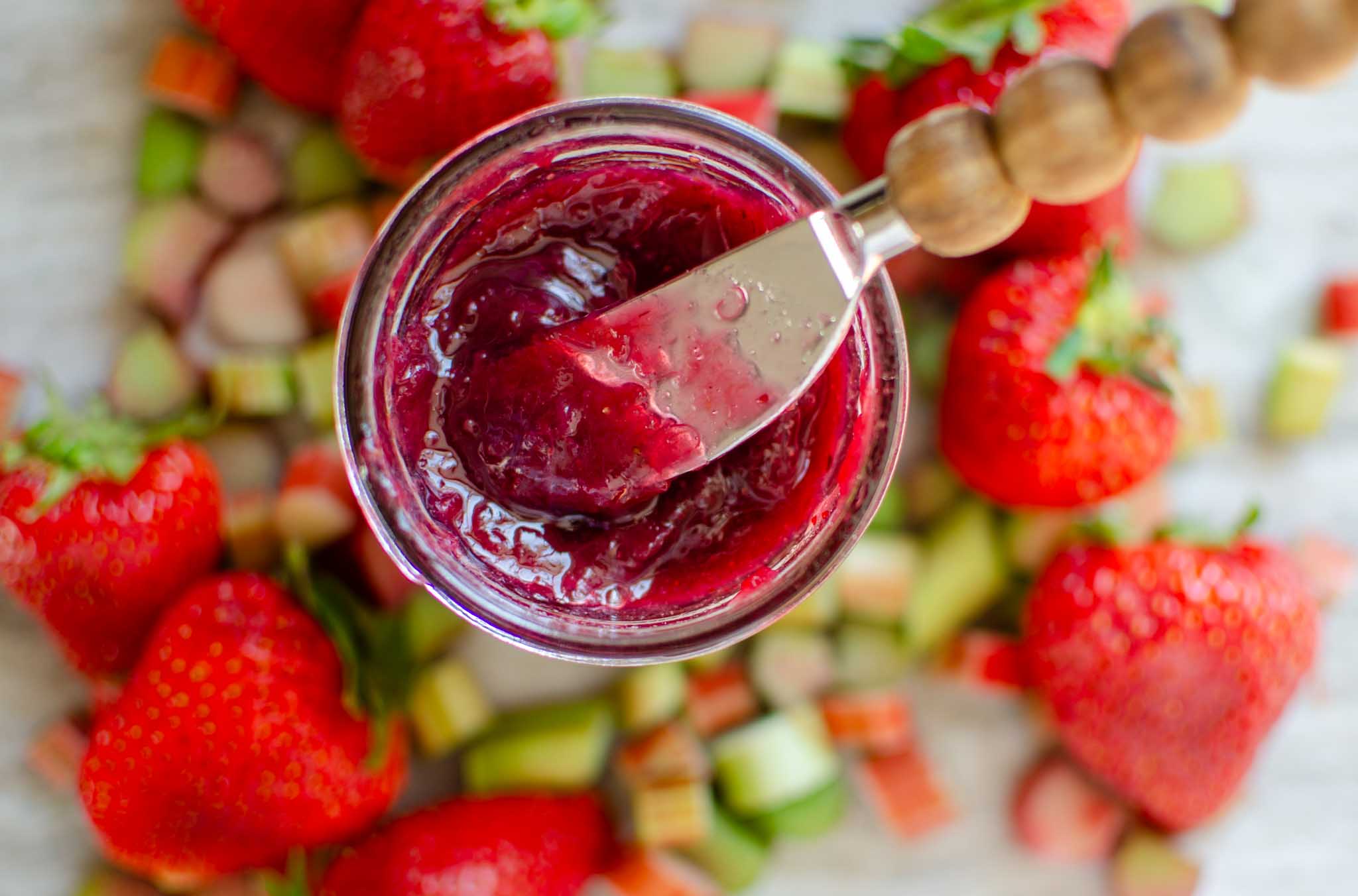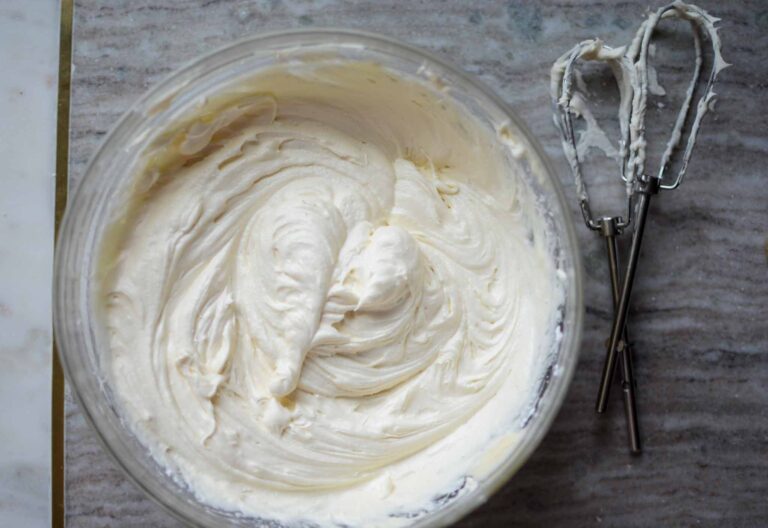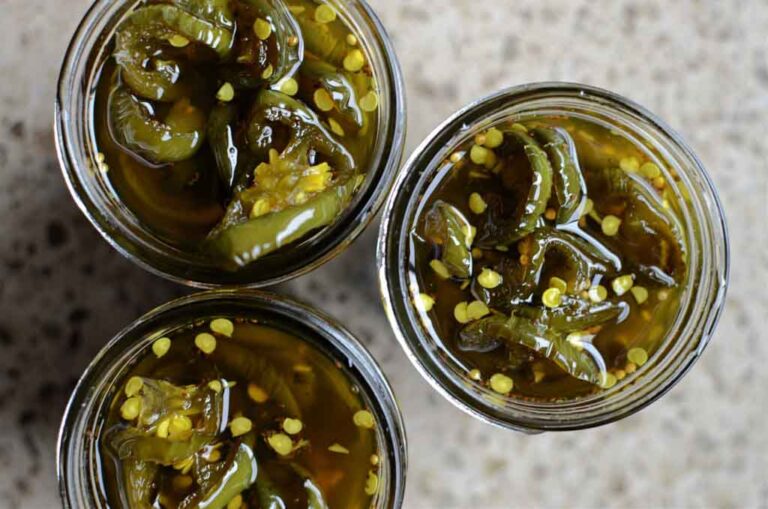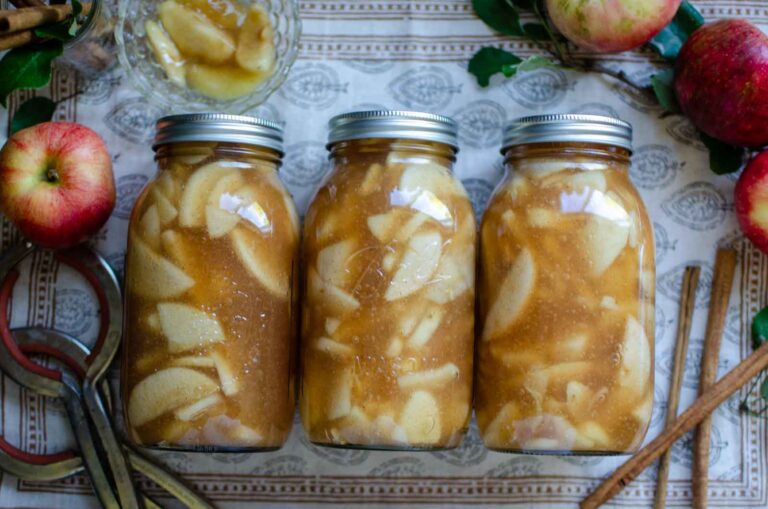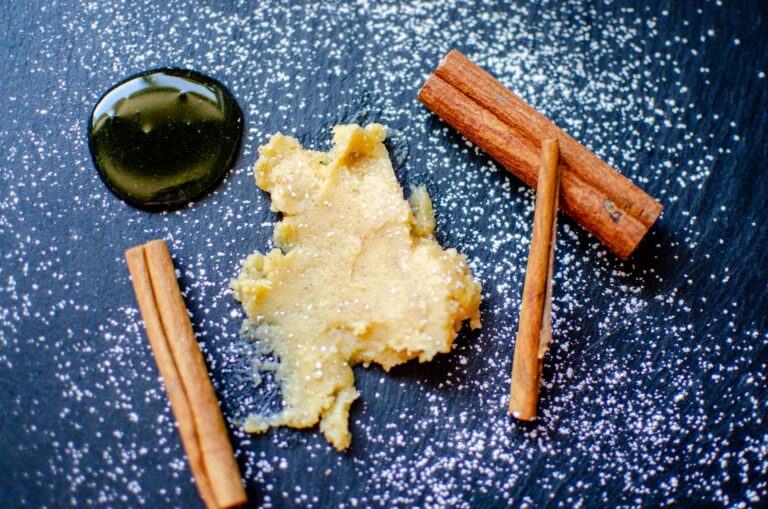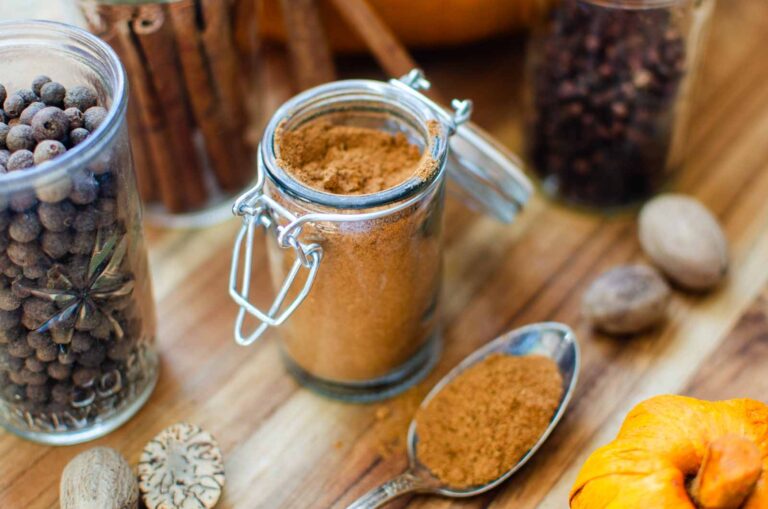Mixed Berry Rhubarb Jam Recipe without Added Pectin
This post may contain affiliate links. As an Amazon Associate, I may receive a small commission, at no cost to you, if you make a purchase. Please read our disclosure policy.
You’ll love this sweet mixed berry rhubarb jam that’s bursting with summer’s sweet and tart flavors in this fruit-forward jam. This homemade rhubarb jam is made with just 5 simple ingredients and all without commercial pectin for it to set. Instead, it relies on sugar and the natural pectin found in lemon juice to achieve a semi-soft . It’s cooked on the stovetop until thick enough to spread.
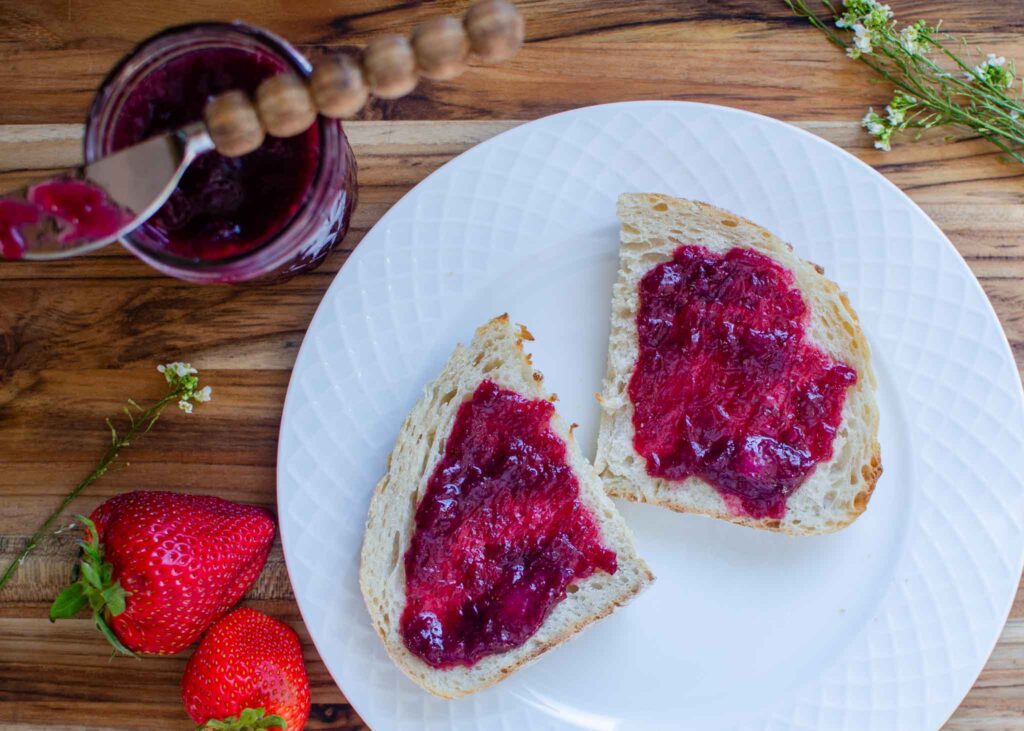
Every spring I get giddy as all the plants push through the dirt and wake from their cold winter slumber. One of the first plants to emerge every spring is our rhubarb plant, officially kicking off rhubarb season. It’s a thing up here in the north. One plant can produce so much rhubarb that there’s plenty to enjoy homemade rhubarb jam, rhubarb sauce, and creamy rhubarb custard bars throughout the summer. It doesn’t matter if your plant has green stalks or bright red stalks, they all have that tart rhubarb flavor which makes for excellent desserts and spreads.
Why You’ll Love Mixed Berry Rhubarb Jam
- This is one of my favorite jams because it uses plenty of fresh rhubarb from the garden as well as fresh or frozen berries for a simple rhubarb jam that’s full of flavor! Similar to classic strawberry rhubarb jam but a bit more complex flavor from using mixed berries.
- It doesn’t have as much sugar as most jams and jellies have. Most jam recipes that have added pectin contain a lot of sugar, often more than the amount of fruit, masking the true flavor of the fruit.
- Use the jam in a variety of ways. Eating it on sourdough or biscuits is my absolute favorite. Homemade jam has been besties with peanut butter for a reason, it’s the perfect balance of sweet and salty. But don’t stop there, spoon a little jam over a scoop of vanilla ice cream, oatmeal, plain yogurt or sourdough pancakes.
- I love that I can adjust the flavor by changing what berries are used. Use whatever kind of berry you enjoy, whether its one kind or a mixture.
How Do You Thicken Jam Without Commercial Pectin?
In order to make jam without pectin, you need fruit, sugar, and time and heat.
Pectin is a type of starch called heteropolysaccharide that occurs naturally in the cell walls of fruits and vegetables. Fruits vary on how much pectin they contain and berries and rhubarb are on the lower end of the spectrum but are high in acid. The acid in the fruit helps to pull out any natural pectin found in the fruit as it simmers. The recipe also adds a touch of lemon juice, which is naturally high in pectin, to further help the jam set.
The temptation when making jam is to reduce the amount of sugar. But the ratio of sugar is crucial for the jam to set, as well as help it to be shelf stable. The fruit along with sugar need plenty of cooking time to drive out the moisture. Because fruit can vary on how much moisture is in it and the exact cooking temperature, the cooking time will vary. Use the thermometer or the tests more than the time to gauge when the jam is ready.
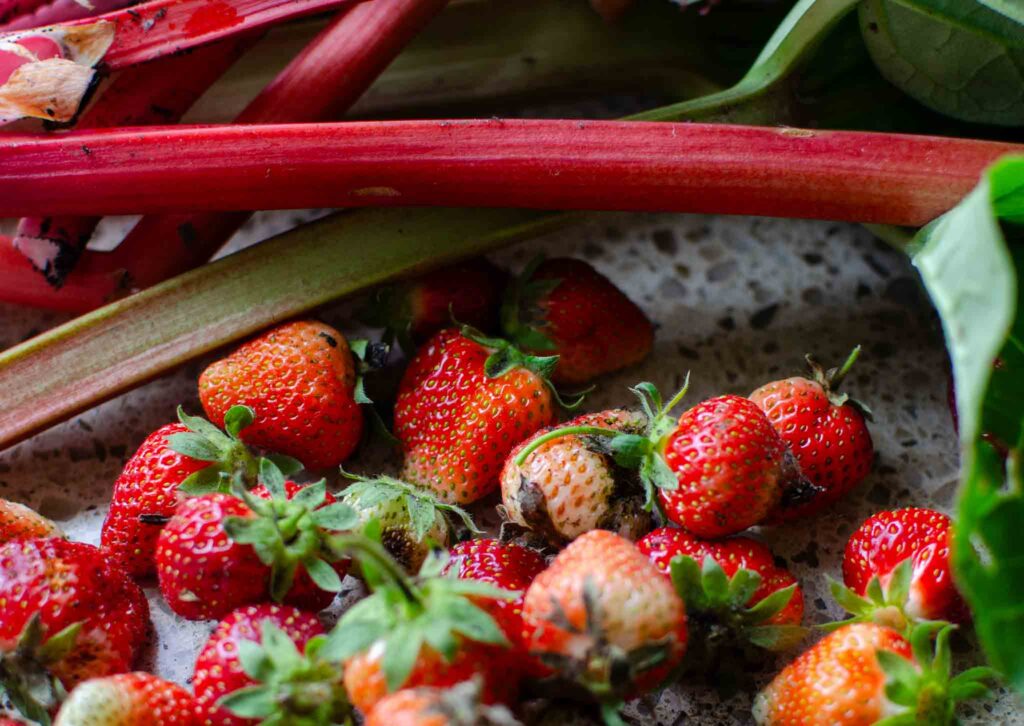
Mixed Berry Rhubarb Jam Ingredients
- Rhubarb – Diced into 1/2-inch pieces.
- Strawberries – Use fresh strawberries when they’re in season, however, frozen strawberries work just as well.
- Blueberries – Similar to the strawberries, use fresh blueberries during the height of the blueberry season and frozen blueberries in the off-season.
- Lemon juice – Normally I love fresh, but in this case, you’ll want to use bottled lemon juice because it has a consistent acid level, which ensures that the jam will set.
- Sugar – Jams need sugar to set and help keep the jam acidic enough to safely preserve it for canning.
Mixed Berry Rhubarb Jam Instructions
Prepare
Begin by removing the large rhubarb leaves and washing the rhubarb stalks. Then cut the stalks into 1/2-inch pieces.
Wash the berries and remove the stem from the strawberries and cut them into 1/2-inch pieces.
Add the chopped rhubarb, cut strawberries, blueberries, and sugar to a large bowl, stirring to cover the fruit with the sugar.
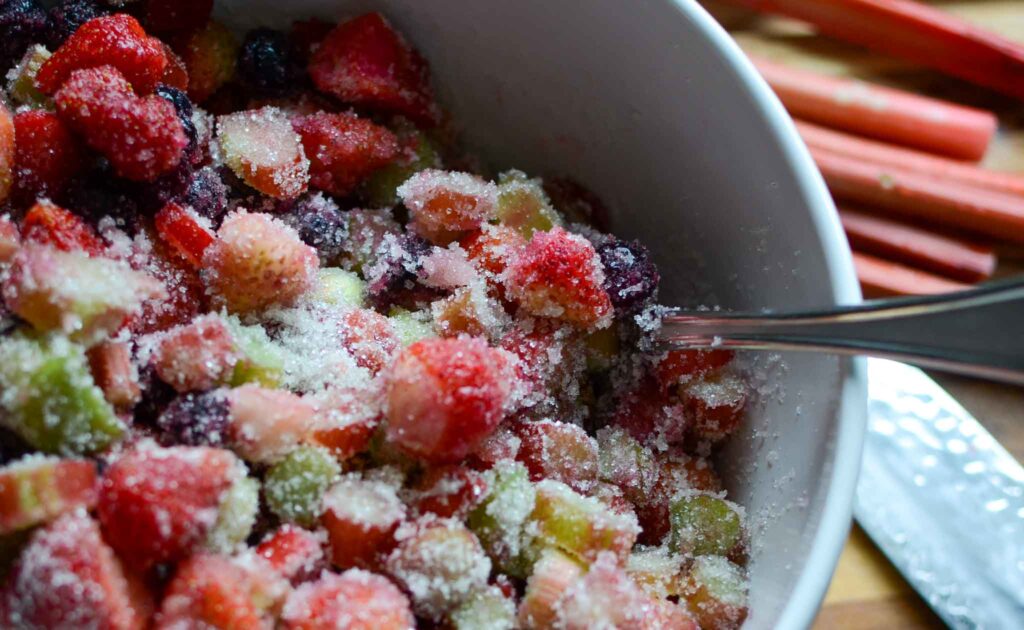
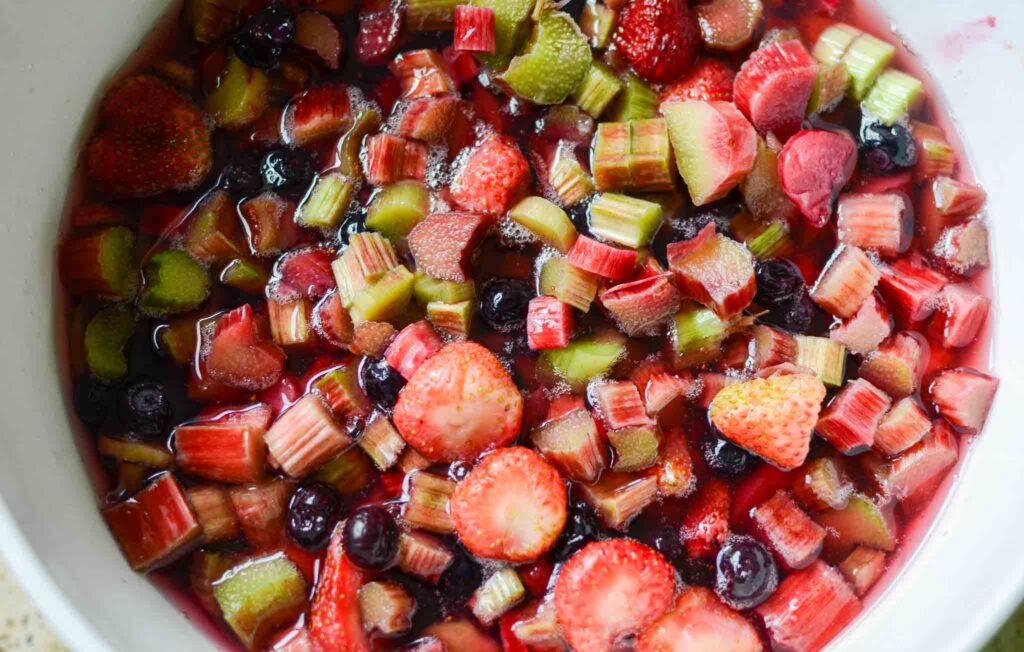
Cover the bowl and place in the refrigerator for at least 12 hours, up to 24 to macerate. This process draws out liquid and softens the fruit.
Cook
Prepare 6 half-pint jars by washing them in hot soapy water. Add them to your water bath canner with the wire rack and bring them to a simmer over medium heat. You will want hot jars when you fill them with hot jam so there’s less chance that the glass will crack.
Place a small finger bowl or small plate into the freezer. These will help us to cool the jam quickly to test that it’s the right consistency.
When you’re ready to can, remove the fruit from the refrigerator and pout it and all of the juice to a large heavy bottom pot along with the lemon juice and salt. The jam can double is size as it cooks so choose a pot with plenty of room in it, opting for a wide pot over a tall pot to allow the moisture to evaporate. Bring the jam to a boil over medium-high heat, stirring occasionally.
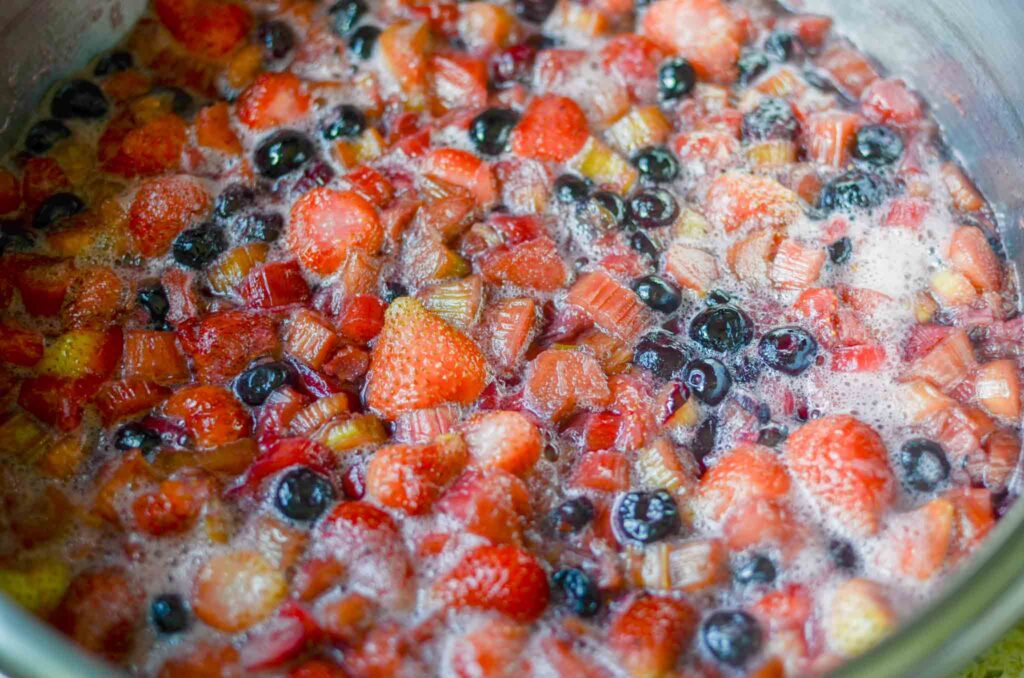
Once the mixture starts to boil it will foam. Stir the foam in and reduce the burner to medium to low heat as the juices simmer rapidly, evaporating some of the liquid. The fruit will begin to break down and the juice will slowly become thicker.
Test
Right around the 20-minute mark is when you can begin to check if it’s ready. The jam will be thickening, make sure that you stir often, scraping the sides so they don’t burn. Use a thermometer to check if it’s ready, aiming for 212-215 degrees.
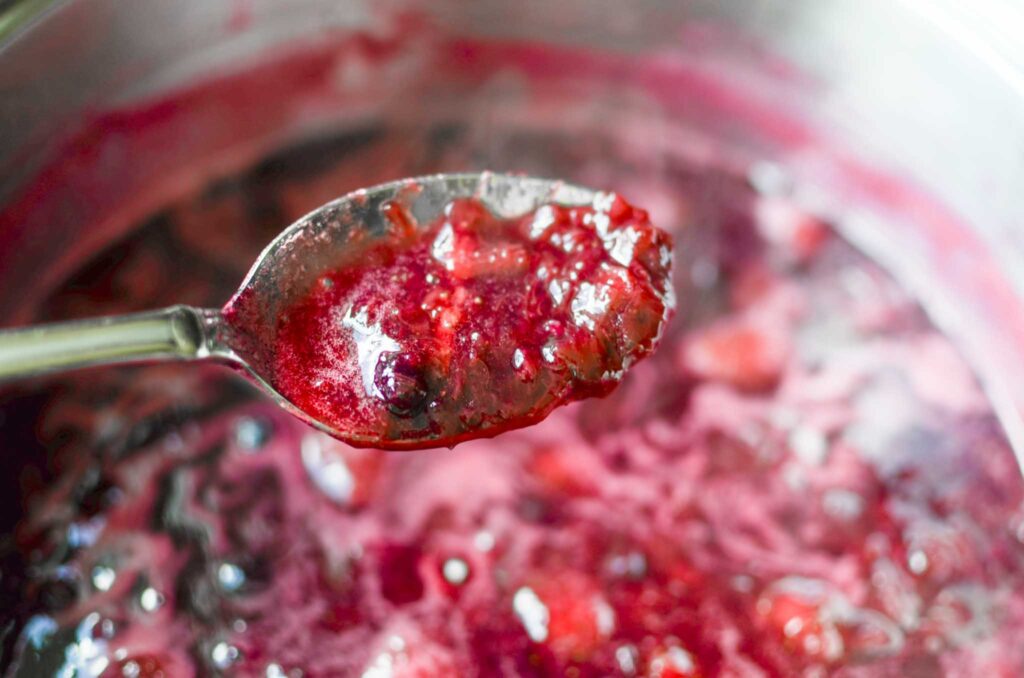
If you don’t have a thermometer, use the spoon test to check the jam. Dipping a spoon into the jam and lifting upwards, the jam will slide off the spoon in a sheet instead of individual drops when the jam is about ready. Another way to check to see if the jam is ready is to spoon a tiny bit onto a cold plate from the freezer and tilt it so that the jam slides down the plate. If it cascades quickly and appears runny, it still needs more time. However, if it moves slowly down the plate, it’s set.
The other way to check is to spoon a small amount of jam onto the cold plate and let it sit for a few seconds to cool. Run your finger through the jam and if it doesn’t flood back together, but slowly inches back toward where you ran your finger, you’ve reached the setting point. You’re ready to ladle the jam into the glass jars.
Can
Lift the jars out of the canning pot and onto a kitchen towel. Place a funnel over the jar and ladle the hot jam into the hot jar, leaving 1/4 inch headspace. Wipe the top of the jars with a clean cloth to remove any jam to ensure that the lid can create a solid seal. Add the two-piece canning lid and twist until finger-tight.
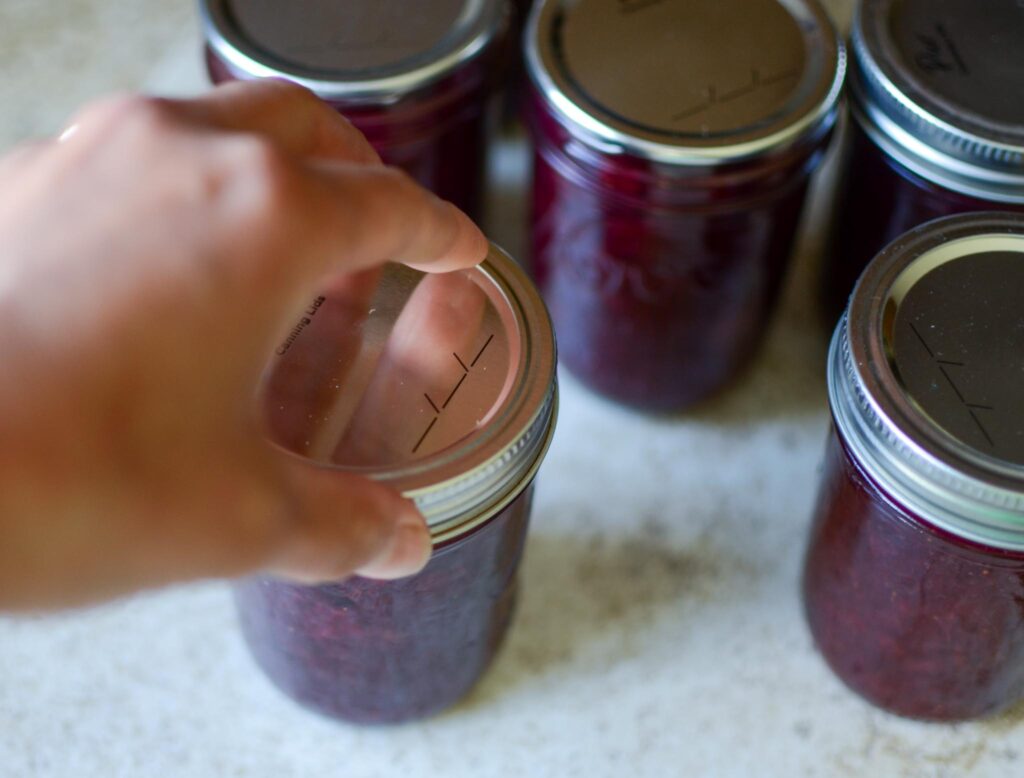
Place the jar into the wire rack and repeat until all of the jars are full. Lower the rack into the canner and bring the water to a boil with the lid on. Once the water in the canner is at a full rolling boil, boil for 10 minutes, turn off the heat and let the jars sit in the water for 5 more minutes.
Using a jar lift, remove the jars from the water bath canner, place on a wire rack to cool to room temperature. You will hear a chorus of popping sounds as the lids seal.

How Do I Know If My Jars Have a Proper Seal?
After 24 hours, check the middle of the lid to make sure they are down tight, creating the seal. Remove the bands and lightly lift on the lid with your fingertips, it should be snug and not move. Move to a dark, cool place to store.
If the lid can move up and down when pressed, then the lid didn’t seal and needs to be placed in the refrigerator immediately.
I’d love to hear from you! Please leave a comment and rate the recipe. Tag photos #Lockremhomestead over on Instagram when you share pictures of your Mixed Berry Rhubarb Jam!
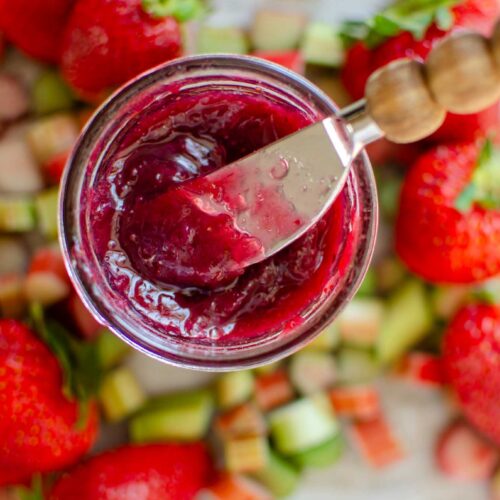
Mixed Berry Rhubarb Jam Recipe without Added Pectin
Ingredients
- 2 pounds rhubarb
- 1 pound berries I used ½ pound each of blueberries and strawberries
- 2½ cups granulated sugar
- 3 tbsp lemon juice
- ¼ tsp salt
Instructions
Prepare
- Begin by removing the large rhubarb leaves and washing the rhubarb stalks. Then cut the stalks into 1/2-inch pieces.
- Wash the berries and remove the stem from the strawberries and cut them into 1/2-inch pieces.
- Add the chopped rhubarb, cut strawberries, blueberries, and sugar to a large bowl, stirring to cover the fruit with the sugar.
- Cover the bowl and place in the refrigerator for at least 12 hours, up to 24 to macerate. This process draws out liquid and softens the fruit.
Cook
- Prepare 6 half-pint jars by washing them in hot soapy water. Add them to your water bath canner with the wire rack and bring them to a simmer over medium heat. You will want hot jars when you fill them with hot jam so there's less chance that the glass will crack.
- Place a small finger bowl or small plate into the freezer. These will help us to cool the jam quickly to test that it's the right consistency.
- When you're ready to can, remove the fruit from the refrigerator and pour it and all of the juice to a large heavy bottom pot along with the lemon juice and salt. The jam can double is size as it cooks so choose a pot with plenty of room in it, opting for a wide pot over a tall pot to allow the moisture to evaporate.
- Bring the jam to a boil over medium-high heat, stirring occasionally. Once the mixture starts to boil it will foam. Stir the foam in and reduce the burner to medium to low heat as the juices simmer rapidly, evaporating some of the liquid. The fruit will begin to break down and the juice will slowly become thicker.
- Right around the 20-minute mark is when you can begin to check if it's ready. The jam will be thickening, make sure that you stir often, scraping the sides so they don't burn. This is when I use a thermometer to check how close it is to being done, aiming for 212-215 degrees.
- If you don't have a thermometer, use the spoon test to check the jam. Dipping a spoon into the jam and lifting upwards, the jam will slide off the spoon in a sheet instead of individual drops when the jam is about ready. Another way to check to see if the jam is ready is to spoon a tiny bit onto a cold plate from the freezer and tilt it so that the jam slides down the plate. If it cascades quickly and appears runny, it still needs more time. However, if it moves slowly down the plate, it's set. The other way to check is to spoon a small amount of jam onto the cold plate and let it sit for a few seconds to cool. Run your finger through the jam and if it doesn't flood back together, but slowly inches back toward where you ran your finger, you've reached the setting point. You're ready to ladle the jam into the glass jars.
Can
- Lift the jars out of the canning pot and onto a kitchen towel. Place a funnel over the jar and ladle the hot jam into the hot jar, leaving 1/4 inch headspace. Wipe the top of the jars with a clean cloth to remove any jam to ensure that the lid can create a solid seal. Add the two-piece canning lid and twist until finger-tight.
- Place the jar into the wire rack and repeat until all of the jars are filled. Lower the rack into the canner and bring the water to a boil with the lid on. Once the water in the canner is at a full rolling boil, boil for 10 minutes, turn off the heat and let the jars sit in the water for 5 more minutes. Using a jar lift, remove the jars from the water bath canner, place on a wire rack to cool to room temperature. You will hear a chorus of popping sounds as the lids are pulled down as they seal.
How Do I Know If My Jars Have a Proper Seal?
- After the jars have sat for 24 hours, check the middle of the lid to make sure they are pulled down tight, creating the seal. Remove the bands and lightly lift up the lid with your fingertips, it should be snug and not move. Move to a dark, cool place to store.If the lid can move up and down when pressed, then the lid didn't seal and will need to be placed in the refrigerator immediately.

